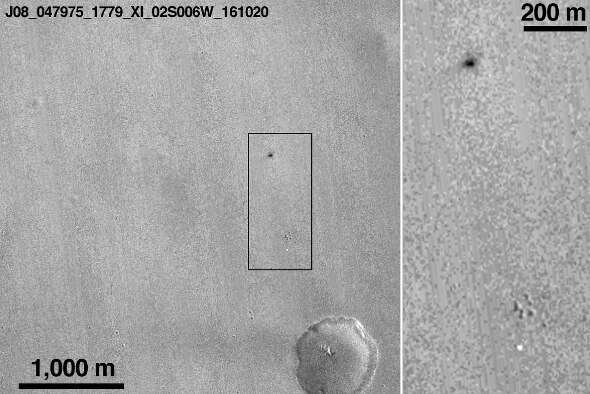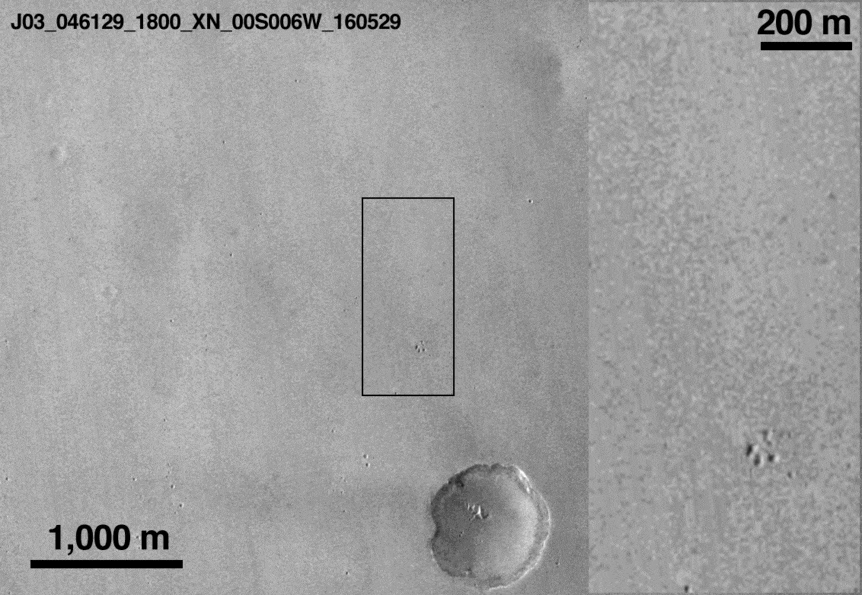Create a free profile to get unlimited access to exclusive videos, sweepstakes, and more!
Mars Lander Impact Site Seen From Orbit

So, half of the European Space Agency’s ExoMars mission went well the other day. The Trace Gas Orbiter is now circling the planet, and appears to be healthy and happy.
Unfortunately, the Schiaparelli lander didn’t do so well. Instead of gently touching down on the surface, an as-yet-undetermined problem shut the landing rockets off while it was still two to four kilometers above the ground. It impacted at an estimated speed of 300 km/hr. That’s 180 mph. Oof.
The image above is from NASA’s Mars Reconnaissance Orbiter, and shows the impact site. The lander’s planned descent was very similar to that of NASA’s Curiosity rover. Its heat shield took the brunt of first slamming through the atmosphere and then was ejected. After that a parachute slowed it further; then it and the back shell attaching it to the lander were ejected. Finally, the lander itself would slow using rockets and drop down to the surface.
In the image near the bottom you can see a bright spot below the cluster of pits to the lower right; that’s likely to be the parachute and back shell. And near the top is the, um, rather large black spot. That smudge is 15 x 40 meters in size, or about half the size of an American football field. The lander’s rockets would disturb the surface as it came down, but not nearly that much. It’s far more likely it’s an impact site.
This animation shows it better:
From telemetry, it seems that the thrusters switched off far too early. That means the fuel tanks were nearly full of propellant, so it’s likely they exploded upon impact. That would explain the size of the impact disturbance. It’s not clear why it happened, but engineers are poring over the data and hopefully will figure it out soon.
This is pretty disappointing, but it’s important to note that that lander was a technology testbed, literally designed and built to test the tech needed to land a future rover or other equipment on Mars. For the most part, the lander was a success! Most of the hardware and software worked, but obviously a very important piece did not.
And more importantly, the Trace Gas Orbiter is doing well. This is an extremely sensitive observatory that will look for methane in the atmosphere of Mars. Methane is a simple carbon-based compound that breaks down easily in the atmosphere. It’s been detected in the air of Mars before, but it’s very diffuse and difficult to nail down. Methane can be created both by geological activity (outgassing from the interior) and by biological action. Obviously, the question of life on Mars looms large, and if it exists and is anything like life here, it might make methane. Detecting the gas is a big clue.
TGO will not only map methane, it will also look for different isotopes of it. A carbon atom usually has six protons and six neutrons. An isotope of an atom has a different number of neutrons; for example, carbon-13 has seven neutrons, not six. Biologically made methane usually has more C12 in it than C13, so mapping the various isotopes can give us clues about the origin of the gas as well.
So let me stress again that TGO is ticking along. And hopefully engineers at ESA will learn enough about what went wrong with Schiaparelli to make sure the next attempt will go a little bit more gently.
We humans have sent a lot of probes to Mars, and nearly half have failed in one way or another. Space exploration is hard. But it’s so very worth it. I hope the folks at ESA working on this remember this as they continue to strive to better understand the Universe around us.



























